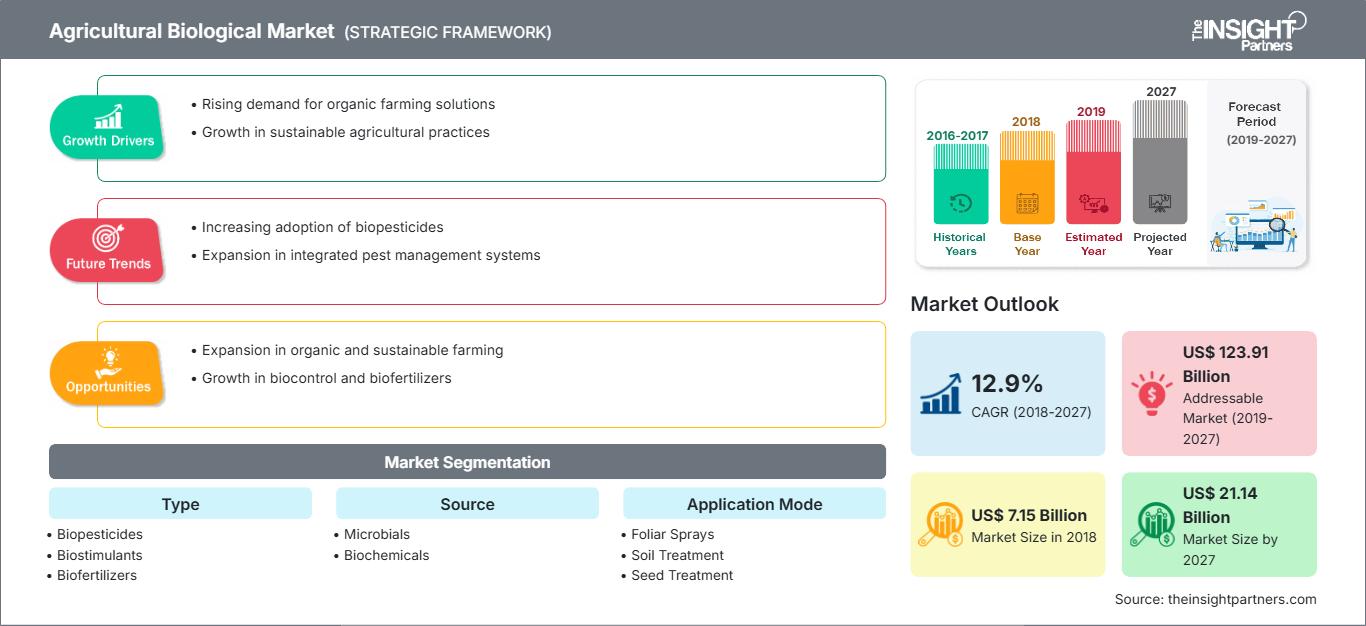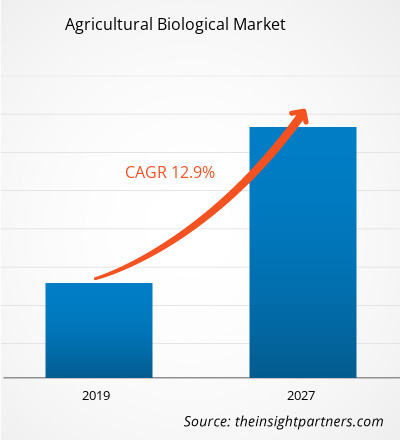[Forschungsbericht]Der Markt für landwirtschaftliche Bioprodukte belief sich im Jahr 2018 auf 7.148,8 Mio. USD und wird im Prognosezeitraum 2019–2027 voraussichtlich mit einer durchschnittlichen jährlichen Wachstumsrate von 12,9 % wachsen und bis 2027 21.141,0 Mio. USD erreichen.
Die Region Nordamerika hatte den größten Marktanteil am globalen Markt für landwirtschaftliche Bioprodukte. Das Wachstum des Marktes für landwirtschaftliche Bioprodukte in dieser Region ist vor allem auf eine Verlagerung der Verbraucherpräferenz hin zu Bio-Lebensmitteln zurückzuführen, gepaart mit steigenden Investitionen in Forschung und Entwicklung. Fördernde Regierungsinitiativen zur Förderung nachhaltiger Praktiken und ein zunehmendes Gesundheitsbewusstsein sind die wichtigsten Faktoren, die den Markt in der Region Nordamerika antreiben.
Markteinblicke: Die zunehmende Verwendung natürlicher Produkte gegenüber synthetischen Produkten hat zum Wachstum des Marktes für landwirtschaftliche Bioprodukte geführt.
Agrarbiologische Produkte werden zunehmend als Ersatz für synthetische oder chemische Pflanzenschutzmittel wie Pestizide, Fungizide oder Insektizide eingesetzt. Landwirtschaftliche Bioprodukte wie Biopestizide, Biostimulanzien und Biodünger dienen als Naturprodukte zur Entwicklung gesunder Böden, zur Bekämpfung von Pflanzenkrankheiten, zur Verbesserung der Nährstoffaufnahme, zur Förderung des Pflanzenwachstums und vielem mehr. Die Nachfrage nach landwirtschaftlichen Bioprodukten steigt gegenüber anderen synthetischen Produkten aufgrund ihrer minimalen Kosten, der geringen Umweltbelastung und des geringen Risikos von Schädlingsresistenzen.
Die steigende Nachfrage nach gesunden Lebensmitteln im asiatisch-pazifischen Raum schafft Wachstumschancen für den globalen Markt für landwirtschaftliche Bioprodukte.
Das wachsende Bewusstsein und die Nachfrage nach gesünderen pflanzlichen Lebensmitteln in Industrieländern wie China, Indien, Japan und Südkorea haben die Hersteller dazu veranlasst, landwirtschaftliche Bioprodukte herzustellen. Auch die Entwicklungsländer im asiatisch-pazifischen Raum bieten aufgrund veränderter Lebensstile, des Wachstums der Mittelschicht, des verfügbaren Einkommens und des zunehmenden Bewusstseins für gesündere Produkte ein enormes Potenzial und enorme Wachstumsaussichten für landwirtschaftliche Bioprodukte.
Passen Sie diesen Bericht Ihren Anforderungen an
Sie erhalten kostenlos Anpassungen an jedem Bericht, einschließlich Teilen dieses Berichts oder einer Analyse auf Länderebene, eines Excel-Datenpakets sowie tolle Angebote und Rabatte für Start-ups und Universitäten.
Agrarbiologischer Markt: Strategische Einblicke

-
Holen Sie sich die wichtigsten Markttrends aus diesem Bericht.Dieses KOSTENLOSE Beispiel umfasst Datenanalysen, die von Markttrends bis hin zu Schätzungen und Prognosen reichen.
Basierend auf der Anwendungsmethode wurde der globale Markt für Agrarbiologie in Blattsprays, Bodenbehandlung und Saatgutbehandlung segmentiert. Das Segment Saatgutbehandlung führte zum globalen Markt für Agrarbiologie. Saatgut wird mit Insektiziden, Fungiziden usw. behandelt, um es vor samenbürtigen Krankheitserregern zu schützen. Saatgut wird auch Sonnenenergie ausgesetzt oder in aufbereitetes Wasser getaucht. Dies bietet verschiedene Vorteile wie verbesserte Keimung, Kontrolle von im Boden vorhandenen Insekten, Vorbeugung von Pflanzenkrankheiten, frühes Wachstum und Etablierung sowie Schutz vor Keimlingsfäule und Samenfäule. Saatgut kann mit verschiedenen Verfahren wie Saatbeizung, Saatpelletierung und Saatgutbeschichtung behandelt werden.
Quelleneinblicke
Der globale Markt für Agrarbiologie ist auf Basis der Quelle in mikrobielle, biochemische und sonstige Mittel unterteilt. Das mikrobielle Segment machte den größten Anteil am globalen Markt für Agrarbiologie aus. Mikroben sind kleine Bakterien und Pilze, die in Pilze, Bakterien, Viren, Protozoen usw. eingeteilt werden können. Sie verbessern die Nährstoffaufnahme des Bodens, bieten Insektenkontrolle zum Schutz vor Krankheiten und steigern den Ertrag. Sie helfen bei der Aufnahme wichtiger Nährstoffe wie Stickstoff, Kalium, Phosphor und Schwefel und sind weithin bekannt für die Lösung grundlegender landwirtschaftlicher Probleme wie Pflanzengesundheitskontrolle, Ernteproduktivität und Erhaltung der Bodengesundheit sowie für Umweltprobleme wie die biologische Sanierung von Boden und Wasser von anorganischen und organischen Schadstoffen.
Fusionen und Übernahmen, die Entwicklung neuer Produkte und andere wurden als die am häufigsten angewandten Strategien auf dem globalen Markt für landwirtschaftliche Bioprodukte angesehen. Einige der jüngsten Entwicklungen auf dem globalen Markt für landwirtschaftliche Biologika sind nachstehend aufgeführt:
- 2018: BASF SE schloss die Übernahme der Bayer AG ab, um seine Saatgutplattform zu stärken und das kürzlich erweiterte Portfolio an landwirtschaftlichen Lösungen zu ergänzen.
- 2018: Koppert Biological Systems gab kürzlich die Einführung seines neuen NatuGro-Systems auf dem kalifornischen Erdbeermarkt bekannt.
- 2018: Marrone Bio Innovations, Inc. brachte TerraConnect auf den Markt, eine neue globale Plattform für biologische Bodenbehandlung und Saatgutbehandlung, die Landwirten leistungsstarke Produkte sowie eine breite Palette wertvoller Werkzeuge zur Verbesserung und zum Schutz ihrer Pflanzen bietet.
Agrarbiologika
Regionale Einblicke in den Markt für landwirtschaftliche BioprodukteDie Analysten von The Insight Partners haben die regionalen Trends und Faktoren, die den Markt für Agrarbiologie im Prognosezeitraum beeinflussen, ausführlich erläutert. In diesem Abschnitt werden auch die Marktsegmente und die geografische Lage in Nordamerika, Europa, dem asiatisch-pazifischen Raum, dem Nahen Osten und Afrika sowie Süd- und Mittelamerika erörtert.
Umfang des Marktberichts für landwirtschaftliche Bioprodukte
| Berichtsattribut | Einzelheiten |
|---|---|
| Marktgröße in 2018 | US$ 7.15 Billion |
| Marktgröße nach 2027 | US$ 21.14 Billion |
| Globale CAGR (2018 - 2027) | 12.9% |
| Historische Daten | 2016-2017 |
| Prognosezeitraum | 2019-2027 |
| Abgedeckte Segmente |
By Typ
|
| Abgedeckte Regionen und Länder |
Nordamerika
|
| Marktführer und wichtige Unternehmensprofile |
|
Dichte der Akteure auf dem Markt für landwirtschaftliche Bioprodukte: Verständnis ihrer Auswirkungen auf die Geschäftsdynamik
Der Markt für Agrarbiologie wächst rasant. Die steigende Nachfrage der Endverbraucher ist auf Faktoren wie veränderte Verbraucherpräferenzen, technologische Fortschritte und ein stärkeres Bewusstsein für die Produktvorteile zurückzuführen. Mit der steigenden Nachfrage erweitern Unternehmen ihr Angebot, entwickeln Innovationen, um den Bedürfnissen der Verbraucher gerecht zu werden, und nutzen neue Trends, was das Marktwachstum weiter ankurbelt.

- Holen Sie sich die Agrarbiologischer Markt Übersicht der wichtigsten Akteure
GLOBALE SEGMENTIERUNG DES LANDWIRTSCHAFTLICHEN BIOLOGISCHEN MARKTES
Nach Typ
Nach Quelle
Nach Anwendungsmodus
Nach Anwendung
Nach Geografie
-
Nordamerika
- USA
- Kanada
- Mexiko
-
Europa
- Deutschland
- Frankreich
- Italien
- Vereinigtes Königreich
- Russland
- Rest von Europa
-
Asien-Pazifik
- Australien
- China
- Indien
- Japan
- Südkorea
- Übriger Asien-Pazifik
-
Naher Osten und Afrika (MEA)
- Südafrika
- Saudi Arabien
- VAE
- Rest MEA
-
Südamerika
- Brasilien
- Argentinien
- Übriges Südamerika (SAM)
Unternehmensprofile
- BASF SE
- Biolchim SpA
- Certis USA LLC
- DowDuPont Inc.
- Isagro SpA
- Koppert Biological Systems
- Marrone Bio Innovations, Inc.
- Syngenta
- UPL
- Valent BioSciences LLC
- Historische Analyse (2 Jahre), Basisjahr, Prognose (7 Jahre) mit CAGR
- PEST- und SWOT-Analyse
- Marktgröße Wert/Volumen – Global, Regional, Land
- Branchen- und Wettbewerbslandschaft
- Excel-Datensatz
Aktuelle Berichte
Verwandte Berichte
Erfahrungsberichte
Grund zum Kauf
- Fundierte Entscheidungsfindung
- Marktdynamik verstehen
- Wettbewerbsanalyse
- Kundeneinblicke
- Marktprognosen
- Risikominimierung
- Strategische Planung
- Investitionsbegründung
- Identifizierung neuer Märkte
- Verbesserung von Marketingstrategien
- Steigerung der Betriebseffizienz
- Anpassung an regulatorische Trends






















 Kostenlose Probe anfordern für - Agrarbiologischer Markt
Kostenlose Probe anfordern für - Agrarbiologischer Markt